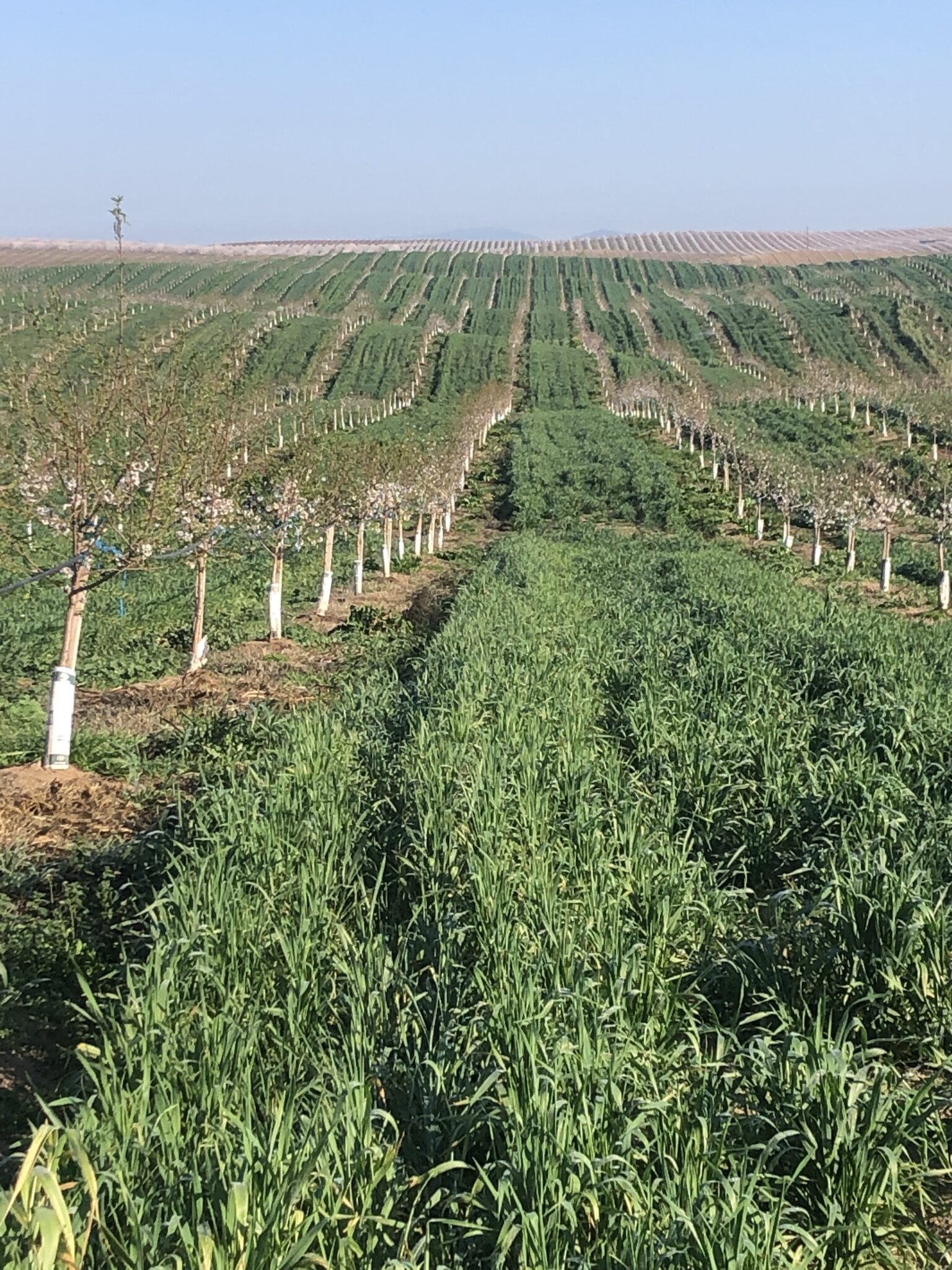
Ward and Rosie Burroughs of Burroughs Family Orchards are finding that being a regenerative farm is financially sustainable. Organic and/or regenerative-grown almonds command a higher price than their conventionally grown counterparts, although the cost to produce them is also higher, Rosie said. But margins and the bottom line aren’t the only reason the Burroughs have chosen regenerative farming.
“We believe in what we’re doing. We realize not everyone can do it, but for us it’s a tremendous fit,” Ward said. “It’s helping our soil health and the biology in our soils.”
It’s also about crop resiliency to a changing climate. “A 1% or 2% difference in temperature can wipe out a crop,” Rosie said. “I think the microbes in the soil can protect our trees with the resilience to endure the extreme climate incidences.”
Only about 1% of the almond orchards in California are farmed with regenerative practices. As part of that 1%, Ward and Rosie and their grown children farm around 1,000 acres in northern Merced County. In 1988 they planted their first almond trees, initially growing almonds conventionally. Around 15 years ago, they switched to organic and then regenerative management.
There are four major practices that are key to running a successful regenerative almond orchard:
1) No tilling: leaving soil undisturbed & maximizing groundcover.
2) Maximizing biodiversity.
3) Maintaining living roots to support soil biology.
4) Minimizing use of synthetic inputs and incorporating use of compost, compost teas, manures or livestock grazing when and where possible.
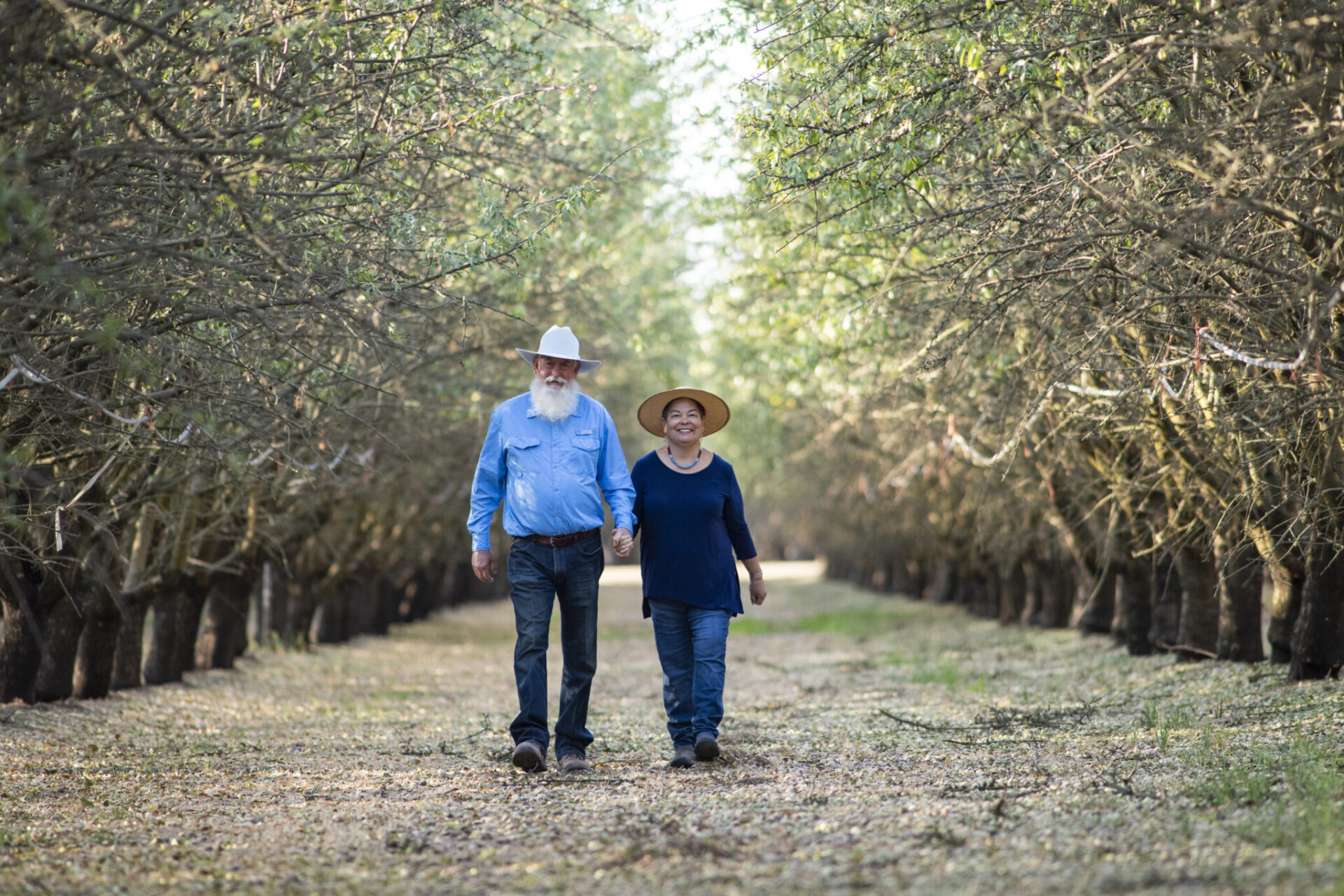
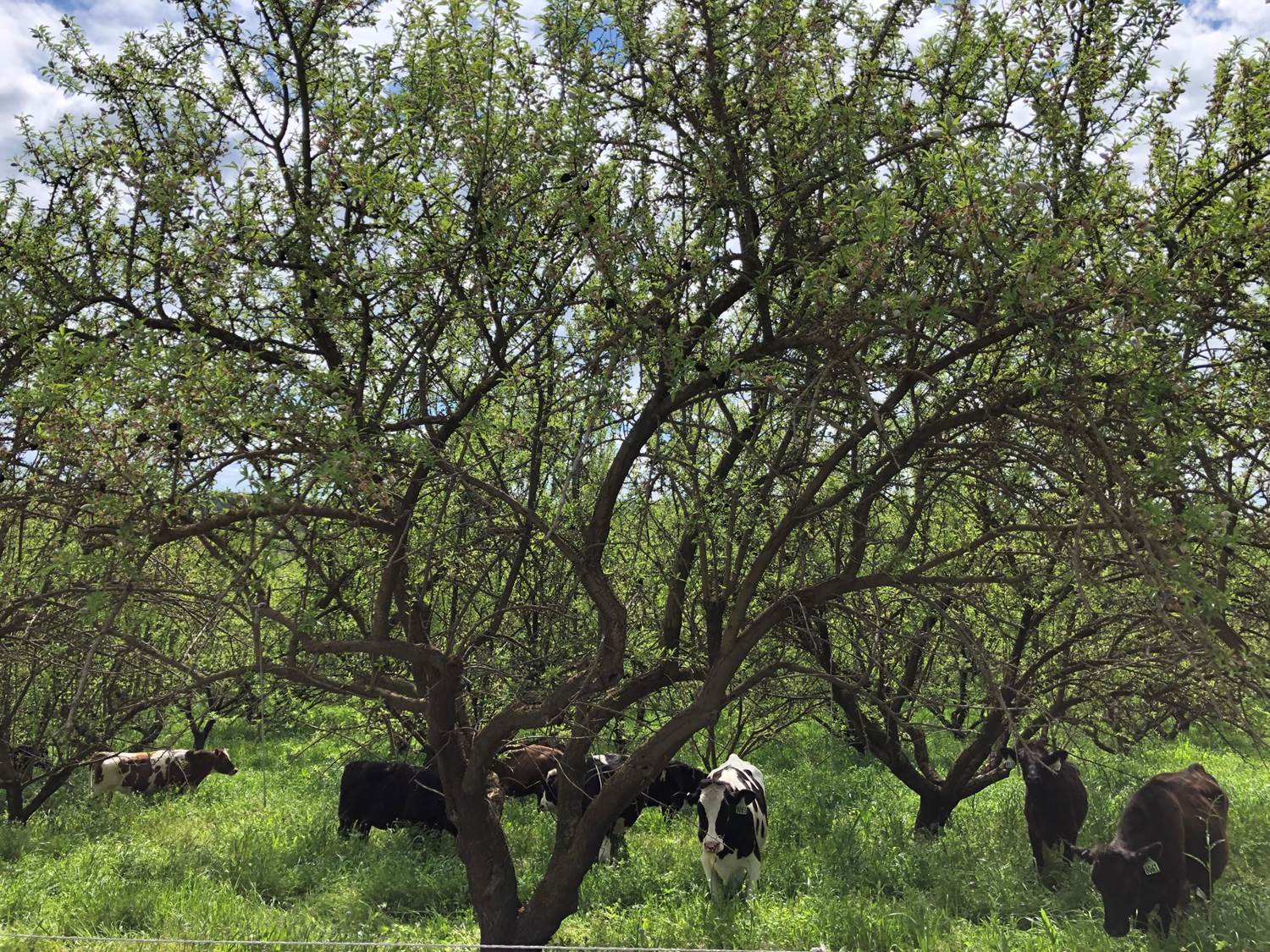
No-Till Cover Crops
The Burroughs use no-till drills to seed their orchards and pastures. They over-seed their pastures twice a year. On pastures with more existing cover, they’ve found that the Sunflower no-till drill works best. On areas with less cover, they use an Aitchison no-till drill.
Once the Burroughs have established a cover crop on the orchard floors, they don’t need to disk, and they don’t need to plant seed every year.
“We let the winter rains bring up the seeds in the ground to be our cover crop in the almonds,” Rosie said.
The Burroughs use native and resident vegetation as cover crops in the wintertime.
“In our older orchards we’re not doing a lot of cover crop seeding. Where we have tried to make sure to plant cover crops is in younger orchards and re-plantings,” Ward said.
In one orchard, they pulled the trees, ground the wood and recycled it back onto the land. They had previously tested the soil and found nematodes. So, they used a mustard and radish mix in the cover crop as recommended to decrease nematode numbers. Last winter, they planted a new orchard in that block. The nematodes are in check and the young trees are doing well.
The Burroughs try to make their cover crops as diverse as possible. They plant cereal grains such as oats, wheat and barley along with some peas and vetch. Often, they will add mustards and daikon radish. Other seed in the cover crop mixes include cow peas, red clover, white clover, forage sorghum, millet, brassicas, vetch, perennial rye grass, fescue, orchard grass, chicory and plantain.
“Diversity and root depth are key in feeding microbes in the soil,” Rosie said.
“Even in our dry, arid summers, we can mow, but still keep that ground covered,” said Ward, noting that 2020 was the toughest year he’s ever experienced for dealing with grass, likely because of the May rains. “We need more legumes in our native grasses. It’s harder to break down the cellulose in the grass.”
The Burroughs don’t irrigate their cover crops, except in young orchards. When they do plant seed, they drill either right before or right after a rain.
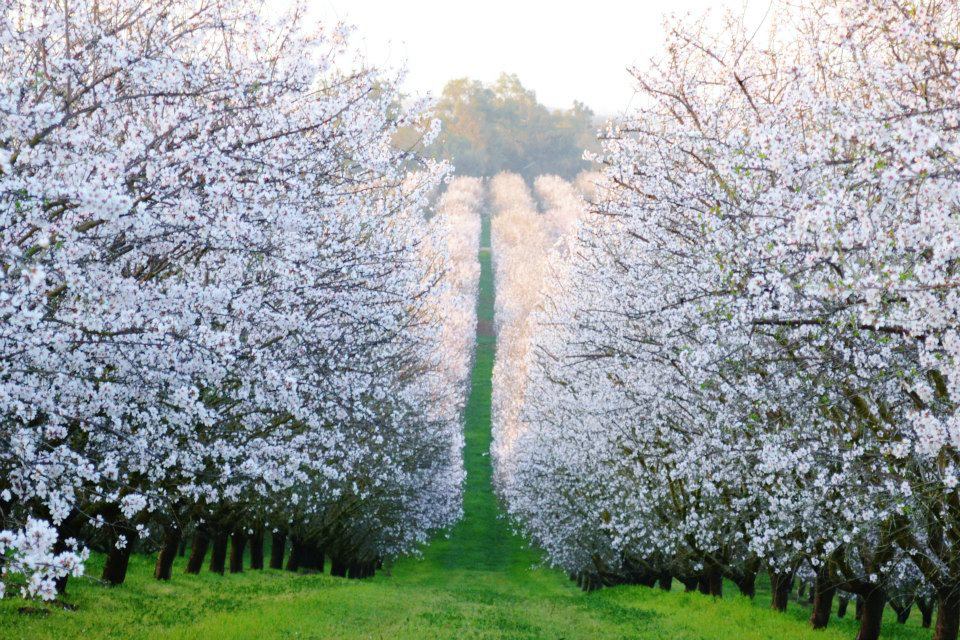
Integrating Livestock
The Burroughs family also own and operate two organic dairies. They did some grazing on the cover crop with dairy cows before the almonds were planted. The cows didn’t just eat the grains; they ate quite a bit of the mustard and radish as well, Ward said.
“It was a tremendous volume of feed,” he said.
The Burroughs got about 7 to 10 days grazing out of it, moving the cows every 12 hours. “It worked really well. We wanted to try to recycle as much as we could, which we did,” Ward said.
In their older orchards, the family runs dairy heifers. Ward warns that the trees can’t be too small, and the heifers can’t be too big. Timing is also important. It’s a short grazing window from December through March. Livestock must be out of the orchard at least 120 days before harvest.
“Rest periods are key,” Ward said about ground cover. “The plants need time to regrow again. Normally between three to four weeks, depending on the time of the year. Root systems that have grown from the plants the livestock have just eaten, that’s what’s feeding the microbes in the soil. That’s what’s putting the carbon in the ground and keeping it there.”
The Burroughs tried sheep in an orchard one spring. The sheep did a good job grazing down the cover crop, but they barked some trees. If you’re going to use sheep, “Make sure sheep have been mineralized so they aren’t craving the bark,” Rosie said.
The Burroughs also use chickens in the winter and spring to recycle nutrients. They have some chicken trailers that fit between the tree rows. The trailers are moved daily.
Compost and Compost Tea
For the past 15 years, the Burroughs have been on a consistent compost regime. They make a fungal-dominated compost with Dr. David Johnson’s beam compost. It takes 12 months to complete each batch.
“We call it our black gold,” Ward said. “What we’re trying to do, of course, is augment the biology of the soil.”
Compost tea is made daily in a 500-gallon brewer. It takes 24 hours to brew, then it is fertigated onto the orchards daily during the growing season – from mid-April until mid-August.
Managing the Orchard Floor
“When you quit spraying herbicide, you get a tremendous amount of vegetation which has to be managed,” Ward said.
The family mounts side mowers on the front of their tractors. They’ve raised the double irrigation drip lines up high enough to be out of the way of the mowers. They mow three times in the early spring to manage orchard floors and continue upkeep of floors until harvest.
In one orchard, they tried a seven-year weed cloth to keep the vegetation from growing directly under the trees. “It was a great way to control weeds,” Ward said. “But the voles came in. They wanted to bark the trees and eat the roots. That was a real negative.”
There are other challenges that pop up with regenerative farming. “In an organic-regenerative orchard, we have more dead wood and more grass to deal with during harvest. We pick up nuts twice; once to condition the almond windrows, which removes the grass, twigs and foreign debris, and the second time to pick up the clean windrows,” Rosie said.
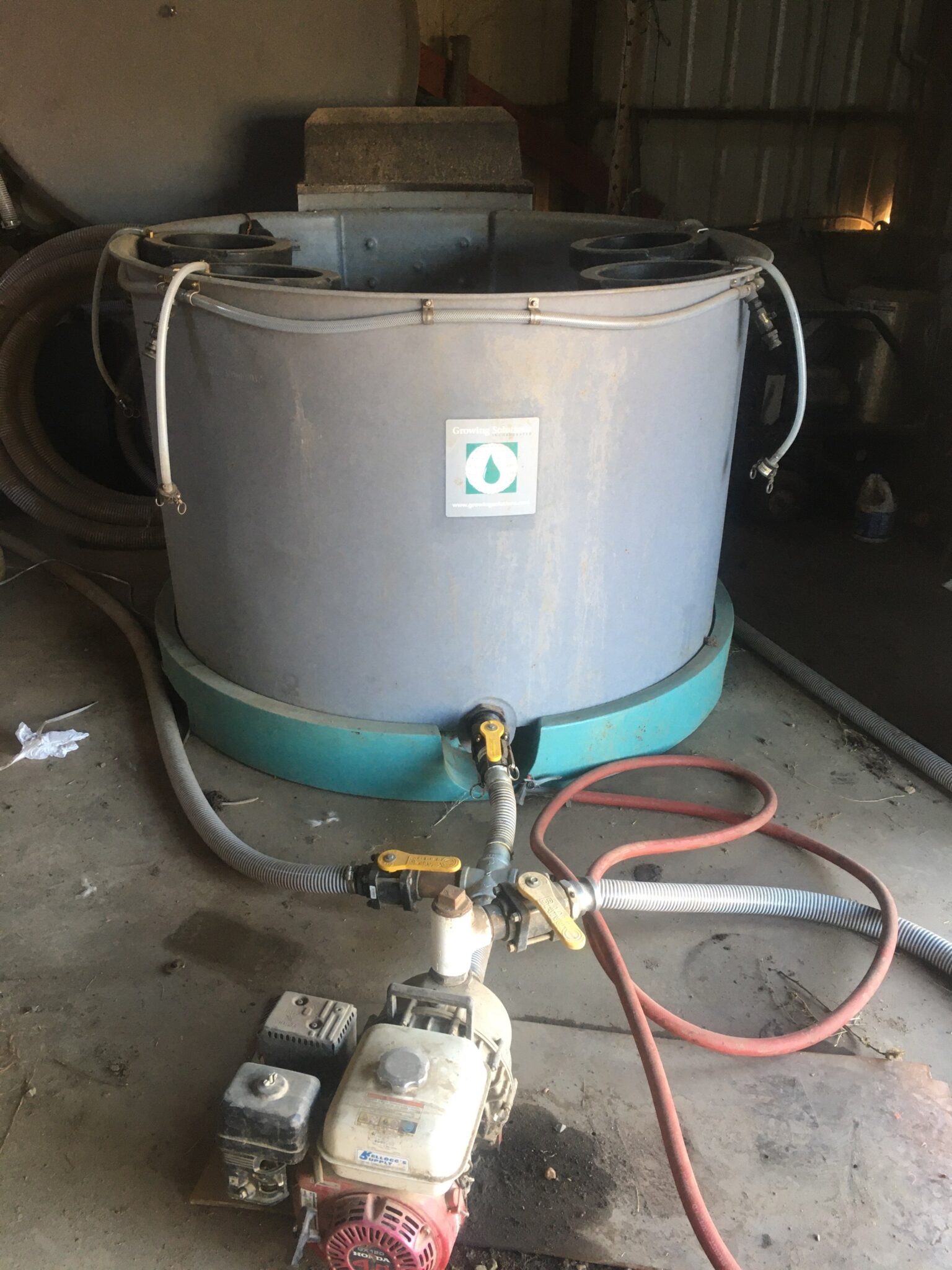
Other Regenerative Considerations
Pruning young trees in the Burroughs’ orchards starts at 42” off the ground, instead of the standard 32”. Ward says the taller trunk height is important going forward with developing catch-frame harvesting for almonds, which will address air quality issues.
The Burroughs installed solar panels in their orchard. They are not in an irrigation district, so they must pump groundwater. It takes 11 pumps to water the almond orchards and the two dairies on 1,900 acres. All have solar installations.
The Burroughs plant hedgerows of natives, including oak, fruit and flowering trees, shrubs and plants as habitat for the beneficial insects and birds.
“We have something in bloom every day of the year,” Rosie said. “Since we’ve become organic/regenerative farmers, every year we’ve had new species of birds finding homes at our place, so our farm has become a sanctuary for wildlife.”
Burroughs Family Orchards was recently included in research done by Tommy Fenster through the Ecdysis Foundation of South Dakota and the Departments of Biology and Earth and Environmental Science, CSU East Bay. The project compared regenerative-farmed almond orchards with conventional orchards.
“We had to find the growers who were leading this charge in regenerative farming. Many people said this couldn’t be done with almonds,” said Dr. Jonathan Lundgren of the Ecdysis Foundation.















